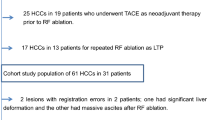Abstract
Objective
The purpose of the present study was to evaluate the usefulness of coronal reformatted images obtained from 64-slice multi-detector computed tomography to assess the ablative margin (AM) in hepatocellular carcinoma (HCC) treated with radio frequency ablation (RFA).
Methods
Ninety-five HCC nodules were analyzed in 66 HCC patients treated with RFA. Two radiologists and one hepatologist independently reviewed axial CT images with or without coronal reformatted images in HCC treated with RFA. Nodules were determined as AM-sufficient (≥5 mm) or AM-insufficient (<5 mm). The level of interobserver agreement was measured using the weighted kappa test. The sensitivity, specificity, and positive and negative predictive values (NPVs) of an insufficient AM (<5 mm) to predict local recurrence were evaluated.
Results
The numbers of AM-sufficient nodules judged by readers 1–3 based on axial images and both axial and coronal images were 56, 49, and 58, and 47, 33, and 48, respectively. Excellent agreement and good to excellent agreement were obtained among the three readers on axial image readings and both axial and coronal image readings, respectively. The mean sensitivity, specificity, and positive and NPVs of an insufficient AM on axial images and both axial and coronal images to predict local recurrence were 64%, 60%, 17%, and 93%, and 95%, 50%, 20%, and 97%, respectively.
Conclusions
Coronal reformatted CT images should be utilized to evaluate the AM in HCC treated with RFA in order to decrease the risk of local recurrence following treatment.




Similar content being viewed by others
References
El-Serag HB, Rudolph KL (2007) Hepatocellular carcinoma: epidemiology and molecular carcinogenesis. Gastroenterology 132:2557–2576
Cho YK, Kim JK, Kim MY, et al. (2009) Systematic review of randomized trials for hepatocellular carcinoma treated with percutaneous ablation therapies. Hepatology 49:453–459
Garrean S, Hering J, Saied A, et al. (2008) Radiofrequency ablation of primary and metastatic liver tumors: a critical review of the literature. Am J Surg 195:508–520
Park MH, Rhim H, Kim YS, et al. (2008) Spectrum of CT findings after radiofrequency ablation of hepatic tumors. Radiographics 28:379–390
Barker DW, Zagoria RJ, Morton KA, et al. (2005) Evaluation of liver metastases after radiofrequency ablation: utility of 18F-FDG PET and PET/CT. AJR Am J Roentgenol 184:1096–1102
Schraml C, Clasen S, Schwenzer NF, et al. (2008) Diagnostic performance of contrast-enhanced computed tomography in the immediate assessment of radiofrequency ablation success in colorectal liver metastases. Abdom Imaging 33:643–651
Yanaga Y, Awai K, Nakaura T, et al. (2008) Optimal contrast dose for depiction of hypervascular hepatocellular carcinoma at dynamic CT using 64-MDCT. AJR Am J Roentgenol 190:1003–1009
Marin D, Catalano C, De Filippis G, et al. (2009) Detection of hepatocellular carcinoma in patients with cirrhosis: added value of coronal reformations from isotropic voxels with 64-MDCT. AJR Am J Roentgenol 192:180–187
Bruix J, Sherman M (2011) American Association for the Study of Liver Diseases. Management of hepatocellular carcinoma: an update. Hepatology 53:1020–1022
Tateishi R, Shiina S, Teratani T, et al. (2005) Percutaneous radiofrequency ablation for hepatocellular carcinoma. An analysis of 1000 cases. Cancer 103:1201–1209
Shiina S, Teratani T, Obi S, et al. (2005) A randomized controlled trial of radiofrequency ablation with ethanol injection for small hepatocellular carcinoma. Gastroenterology 129:122–130
Tokunaga S, Koda M, Matono T, et al. (2012) Assessment of ablative margin by MRI with ferucarbotran in radiofrequency ablation for liver cancer: comparison with enhanced CT. Br J Radiol 85:745–752
Inoue T, Kudo M, Hatanaka K, et al. (2013) Usefulness of contrast-enhanced ultrasonography to evaluate the post-treatment responses of radiofrequency ablation for hepatocellular carcinoma: comparison with dynamic CT. Oncology 84(Suppl 1):51–57
Tomonari A, Tsuji K, Yamazaki H, et al. (2013) Feasibility of fused imaging for the evaluation of radiofrequency ablative margin for hepatocellular carcinoma. Hepatol Res 43:728–734
Kim KW, Lee JM, Klotz E, et al. (2011) Safety margin assessment after radiofrequency ablation of the liver using registration of preprocedure and postprocedure CT images. AJR Am J Roentgenol 196:W565–W572
Koda M, Tokunaga S, Miyoshi K, et al. (2012) Assessment of ablative margin by unenhanced magnetic resonance imaging after radiofrequency ablation for hepatocellular carcinoma. Eur J Radiol 81:2730–2736
Lee EY, Zucker EJ, Tsai J, et al. (2011) Pulmonary MDCT angiography: value of multiplanar reformatted images in detecting pulmonary embolism in children. AJR Am J Roentgenol 197:1460–1465
Tsili AC, Argyropoulou MI, Gousia A, et al. (2012) Renal cell carcinoma: value of multiphase MDCT with multiplanar reformations in the detection of pseudocapsule. AJR Am J Roentgenol 199:379–386
Acknowledgments
The authors thank Dr. Fumihiko Kanai (Medical Corporation Eikenkai) for the valuable discussions.
Conflict of interest
There is no conflict of interest to disclose.
Author information
Authors and Affiliations
Corresponding author
Additional information
Tenyu Motoyama and Sadahisa Ogasawara contributed equally to this work.
Rights and permissions
About this article
Cite this article
Motoyama, T., Ogasawara, S., Chiba, T. et al. Coronal reformatted CT images contribute to the precise evaluation of the radiofrequency ablative margin for hepatocellular carcinoma. Abdom Imaging 39, 262–268 (2014). https://doi.org/10.1007/s00261-013-0054-0
Published:
Issue Date:
DOI: https://doi.org/10.1007/s00261-013-0054-0




